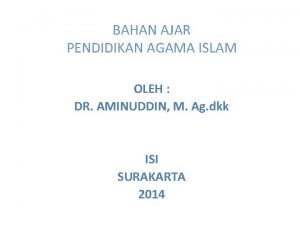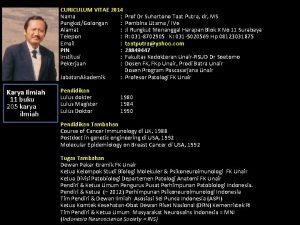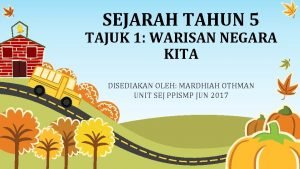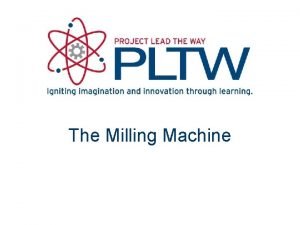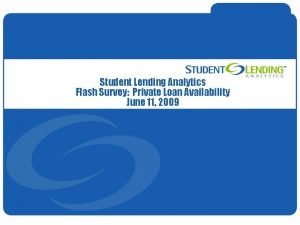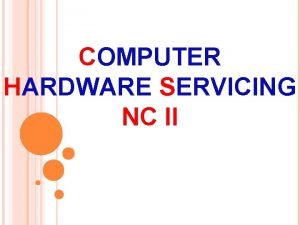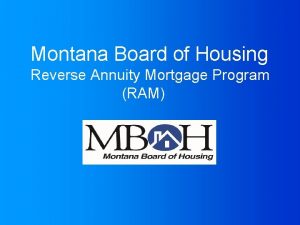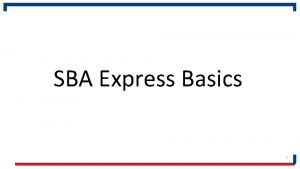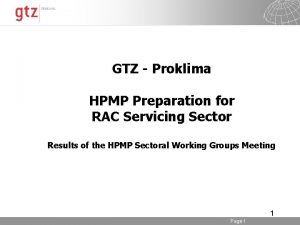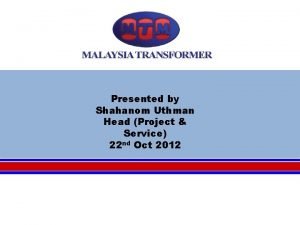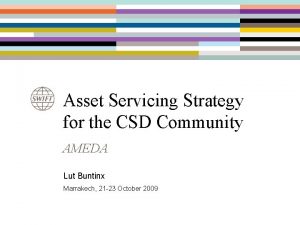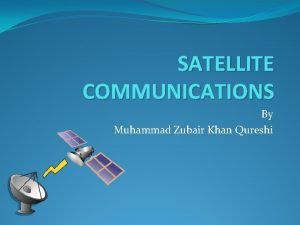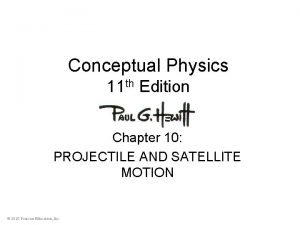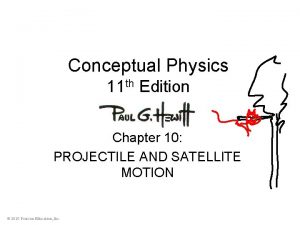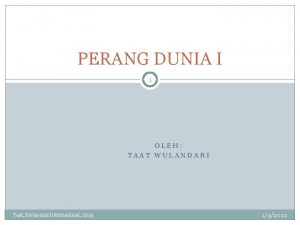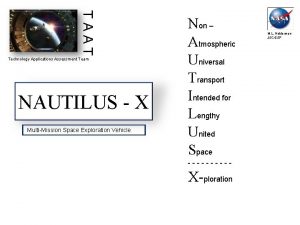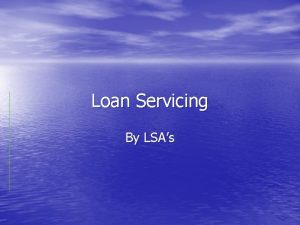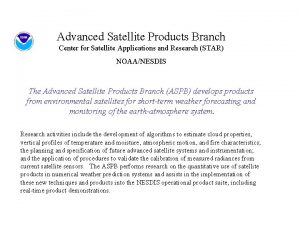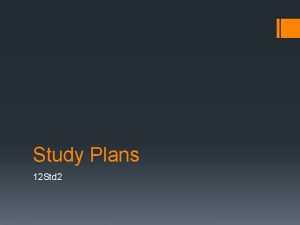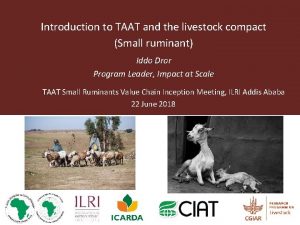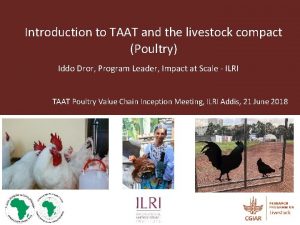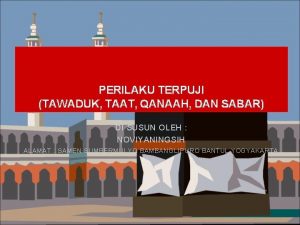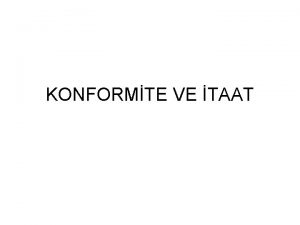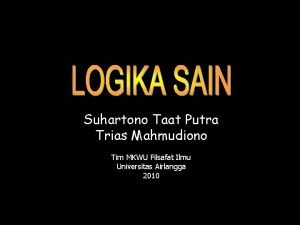TAAT Study Team Applications and Plans Satellite Servicing

















- Slides: 17

TAAT Study Team Applications and Plans Satellite Servicing ISRU SBSP Edward. M. Henderson@nasa. gov Solar Electric Propulsion Propellant Depot Mack Henderson FISO/January 26, 2011 MMSEV

TAAT OBJECTIVES • Identify key technologies that can advance Space Exploration • Determine technology interaction to achieve common goals • Define technology demonstrations that can be done soon - what are affordable - what can be partnered Maximize use of existing Assets- facilities, H/W, FSW, skills, etc. 2

TAAT Activity • The Technology Applications Assessment Team selected several applications that would add value for Exploration • The Team is independently assessing these applications for future implementation • The Team is supporting similar technology assessments in other areas: – – DARPA/NASA tasks Mac. Gyver team Human Exploration Framework Team (HEFT) Office of the Chief Technologist (OCT) CISS Commercial In-Space Servicing – Future in Space Operations (FISO) 3

Technology Applications (Leads) 1. Satellite Servicing Mission(s) (Ted Talay) 2. ISRU Lunar Mission (Paul Spudis/Bill Rothschild) 3. Space Based Solar Power Demo (Bill Rothschild) 4. Solar Electric Propulsion Vehicle (Larry Schmidt/Sonny White) 5. Propellant Depot (Wally Twichell) 6. Multi-Mission Space Exploration Vehicle (Mark Holderman) Lead Develops Plan 4

Satellite Servicing Assessments Description: To support satellite servicing studies underway in the Agency (HQ, GSFC, JSC) and DARPA. • Identify transportation options, human habitation, and space vehicle options that can support satellite servicing scenarios. • Identify technologies (e. g. heavy-lift launch) that can enable or enhance human and robotic servicing missions • Examine the commercial viability of satellite servicing for ops scenarios, concepts & technologies identified. • Define a near-term, servicing demonstration mission Approach: • Interface with NASA/DARPA study teams to provide support in areas noted • Conduct Notional Mission trades and definition especially in human GEO servicing and use of heavy-lift launch systems. • Identify key technologies, ops scenarios, and system concepts • Integrate into a near-term servicing demonstration mission definition Justification: • Supports requests from NASA, GSFC, JSC, SOMD, OCT, DARPA stakeholders • Provides data to same to support decision-making Schedule/Cost: • Support NASA/DARPA Manned GEO Servicing Study thru April 2011 • Support GSFC Servicing Study thru April 2011 • Demonstration Mission Definition - Large, multi-satellite GEO servicing (provide life extension via end-of-life relocations)

ISRU Water Processing Demo Find, extract, process, and store water on the Moon - Single launch on an Atlas V-551 - 6, 420 kg Lunar Lander (GLOW) - Landing near a crater at the Moon’s North Pole - Prospecting rover in crater where water ice exists - Dig lunar feed stock and haul to processing plant - Demonstrate water extraction and storage Rozhdestvensky N Multiple sources provide clear evidence of water in this crater 11 12 13 14 15 ATP Key Demo Technologies - Precision navigation and landing near the crater rim at the Moon’s North Pole - Pair of Comm/Nav Sats in lunar orbit - High power PV array - Deployable Rover; rechargeable batteries - Prospecting sensor suite to find water - Diggers suitable for lunar regolith - ISRU processing plant - Water storage on the Moon FA PDR CDR TRR 16 17 Launch FB FC FD FRR PRELIMINARY ROM Cost 18 Prog Mgmt / SE&I Comm/nav sats Lunar Lander (1655 kg) Rover (530 kg) ISRU Processor (210 kg) Launcher (Atlas V) Operations Segment Mgmt Reserve (300 kg) Total FE $120 M $ 70 M $250 M $100 M $ 50 M $180 M $ 20 M $100 M $900 M 6

Space Based Solar Power Beaming Demo Proof of concept for wireless power transmission from space Ground to Space Laser -Significant power levels > 25 k. W to users -Safe and controllable power beaming from space to ground (Microwave) -Growth paths for exploration, military and commercial applications Solar Dynamic Satellite Space to Ground Microwave -Closely coupled with solar power concept -Growth paths for space to space power beaming applications Key Demo Technologies P Be ilot am Proof of concept for Ground to Space Laser power beaming Atlas V Rectenna Solid State Laser Demo Schedule / ROM Cost - Retrodirective phase lock beam control - High power solid state laser - Inflatable solar power concentrator - Solar dynamic power generator - High energy flywheels - High efficiency microwave converters - Large deployable rectenna farm PRELIMINARY Prog Mgmt / SE&I Satellite Bus (330 kg) SBSP Payload (6, 200 kg) Launcher (Atlas V) Ground Segment Operations Segment Other (250 kg) Mgmt Reserve (850 kg) Total B Bill Rothschild wjrothschild@yahoo. com 713 -248 -2882 $185 M $115 M $470 M $175 M $150 M $ 40 M $ 25 M $145 M $1. 3 7

SEP Demo Description: Perform high power SEP demonstration • 30 k. W solar power • Battery augmentation to facilitate 200 k. W short duration • Total system delta-v: ~15 km/sec • System will demonstrate two high power EP engine technologies: VASIMR & Hall_or_ION • Demo will also make use of mini free flying inspection spacecraft • Utilize emerging advanced solar technologies such as DARPA’s FAST or SOLAROSA. Approach Schedule/Cost: • Vehicle can launch to LEO on Falcon 9 • Vehicle can achieve Mars orbit • Delta-v split between two EP technologies • Design, Development, Test, & Evaluation ~4 years • Launch Vehicle Categories: Falcon 9, Atlas V, Delta IV – final variant depends on final SEP tug mass and cargo • Cost estimate: ~$500 million (includes launch cost on F 9) Justification: • All future exploration plans beyond LEO will make use of SEP technology elements in the architectures. • SEP is a requirement for manned exploration beyond CIS-Lunar space. • SEP is orders of magnitude more efficient than chemical and will result in smaller vehicle architectures, and allow selection of smaller (and cheaper) launch vehicles 8

Depot at GEO Description and Objectives • Provide storage for satellite pressurants and propellants in orbit in close proximity to multiple users. • Provide docking and replenishment service to robotic satellite servicing vehicle. • Enable extension of service life to on orbit satellites. • Enable multiple servicing missions by robotic servicing vehicle. • Reduce cost of satellite servicing missions. Approach Cost and Schedule • Maximize use of existing satellite technology • Mature AR&D and on orbit fluid transfer technologies • System includes depot and tanker • Robotic Servicing Vehicle developed in separate joint DARPA/NASA program • Allow commercial delivery of fluids to Depot by commercial operators. Justification • Provides significant national capability • Expands opportunities for commercial space Phase 1 DDT&E: $150 M 9

MMSEV (Multi-Mission Space Exploration Vehicle) Technology Applications Assessment Team Description and Objectives: • • • Long-duration space journey vehicle for crew of 6 for periods of 1 -24 months CIS-lunar would be initial Ops Zone [shakedown phase] Exo-atmospheric, Space-only vehicle Integrated Centrifuge for Crew Health ECLSS in deployed Large Volume w/ shirt-sleeve servicing Truss & Stringer thrust-load distribution concept (non-orthogird) Capable of utilizing variety of Mission-Specific Propulsion Units [integrated in LEO, semi-autonomously] Utilizes Inflatable & Deployed structures Incorporates Industrial Airlock for construction/maintenance Integrated RMS Supports Crewed Celestial-body Descent/Return Exploration vehicle(s) Utilizes Orion/Commercial vehicles for crew rotation Approach: • Multiple HLV (2 -3) & Commercial ELV launches • On-orbit LEO Integration/Construction • First HLV payload provides Operational, self-supporting Core • Centrifuge utilizes both inflatable & deployed structures Collaborators/Roles: • • • JPL: Deployment Integ. , Communications/Data Transmission AMES: ECLSS, Bio-Hab GSFC: GN&C, Independent System Integrator GRC: Power. Pumps, PMD, External Ring-flywheel La. RC: Hoberman deployed structures & Trusses MSFC: Propulsion Unit(s) & Integration platform , Fluids Transfer & Mgmt. • JSC: Proj. Mgmt – SE&I , ECLSS, Centrifuge, Structures, Avionics, GN&C, Software, Logistics Modules • NASA HQTRS: Legislative & International Lead Non – Atmospheric Universal Transport Intended for Lengthy United States ------X-ploration • M. L. Holderman JSC/SSP Justification: • Provides Order-of-Magnitude increase in long duration journey capability for sizeable Human Crews • Exploration & Discovery • Science Packages • Meets the requirement of Sec. 303 MULTIPURPOSE CREW VEHICLE Title III Expansion of Human Space Flight Beyond the International Space Station and Low-Earth Orbit, of the “National Aeronautics and Space Administration Authorization Act of 2010” COST: $ 3. 7 B DCT & Implementation 64 months M. L. Holderman - JSC/SSP 10

Applications Concept Definition Plan • Brief description of the Application, including a quad chart • Identify launch systems and existing assets being used • Concept of Operations and Design Reference Mission • Design description including configurations, main subsystems, and performance sensitivities • Identify Challenges and key risks • Identify Partnering Opportunities: Other Centers, Contractors, Government Agencies, Internationals, etc. • Who are the potential Customers • How Application interacts with other technologies to support Exploration plans • Define a rough development schedule, including the projected first flight date and a Development cost “Swag” 11

TAAT Milestones OCT NOV DEC JAN ‘ 11 FEB MAR Weekly Reviews Mac. Gyver Brief Preliminary Plans SSP Review CISS Brief JSC SOMD Review FISO Brief JSC Review Final Plans SSP Review SSP HQ Review 12

Technology Applications Roadmap 2011 Shuttle 2015 2020 Retire 2011 EELV Falcon 9 Taurus II 70 -100 m. T ISS Satellite Servicing Robotic Sat. Servicing 130 m. T Super Heavy Human Sat. Servicing ISS Dextre Demo ISRU Small Scale SBSP Full Scale SBSP ISRU High Orbit Demo ISS Demo SEP Sojourner-X 200 Aurora ISS Demo LP Depot GEO Depot Fluid Transfer ISS MMSEV Vac. Chamber Demo AG ISS 13

Space Exploration Infrastructure Concept 14

TAAT Interactivity EELV COM/COTS 2010 HEFT SEP GEO EELV NASA/DARPA Sat. Serv. Moon Falcon 9 Taurus II HLV Mac. Gyver SBSP LP HLLV OCT/CISS ISRU MMSEV Depot NEO Break Point Analysis FISO 2020 Mars 70 -100 m. T 130 m. T Super Heavy 15

Summary • The team has identified six technology applications for assessment • Technologies were selected based the collective benefits for future Exploration • Leads for each application are assigned to develop a plan • Preliminary plans ready for review • TAAT overview has been shared with other teams • The team will continue to assess recommended applications for further development 16

Forward Plans • Share preliminary plans with SOMD and Center(s) management • Continue to refine and mature plans consistent with management direction • Perform necessary trade studies to determine the best application demonstrations • Continue to coordinate with other teams on common goals • Brief candidate partners on TAAT concepts and solicit participation agreements • Update plans formal review with appropriate NASA management by March 17
 Taat kepada ulil amri merupakan
Taat kepada ulil amri merupakan Prof dr suhartono taat putra
Prof dr suhartono taat putra Contoh warisan negara
Contoh warisan negara Milling machine maintenance checklist
Milling machine maintenance checklist Student lending analytics
Student lending analytics Computer hardware servicing nc2
Computer hardware servicing nc2 Montana reverse mortgage
Montana reverse mortgage Mortgage krizi
Mortgage krizi Sba sop 50 57 2
Sba sop 50 57 2 Rac servicing
Rac servicing Tap changer servicing
Tap changer servicing Asset servicing solutions
Asset servicing solutions Going native project management
Going native project management Team spirit becomes team infatuation
Team spirit becomes team infatuation The white team cheers for the blue team, just like
The white team cheers for the blue team, just like Geosynchronous vs geostationary
Geosynchronous vs geostationary Chapter 10 projectile and satellite motion tossed ball
Chapter 10 projectile and satellite motion tossed ball Chapter 10 projectile and satellite motion
Chapter 10 projectile and satellite motion
